Myofascial Pain Syndrome and Acupuncture: A Comprehensive Guide
Myofascial Pain Syndrome (MPS) is a chronic condition that affects millions of people worldwide, causing persistent muscle pain and discomfort. Unlike other pain disorders, MPS is characterized by localized pain in specific muscle groups, often triggered by tight knots called trigger points. For those seeking relief, acupuncture has emerged as a promising treatment option. This detailed guide explores Myofascial Pain Syndrome, its symptoms, causes, and the role of acupuncture in managing this condition. Part 1 delves into understanding MPS, while Part 2 examines acupuncture as a treatment, including its effectiveness, key acupoints, benefits, and potential side effects.
- Understanding Myofascial Pain Syndrome
- What is Myofascial Pain Syndrome?
- Symptoms of Myofascial Pain Syndrome
- Causes of Myofascial Pain Syndrome
- Risk Factors
- Diagnosis of Myofascial Pain Syndrome
- Conventional Treatments for Myofascial Pain Syndrome
- Acupuncture for Myofascial Pain Syndrome
- What is Acupuncture?
- Effectiveness of Acupuncture for Myofascial Pain Syndrome
- Key Acupoints for Myofascial Pain Syndrome
- Benefits of Acupuncture for Myofascial Pain Syndrome
- Potential Side Effects of Acupuncture
- What to Expect During an Acupuncture Session
- Tips for Maximizing Acupuncture’s Benefits
- Conclusion
Understanding Myofascial Pain Syndrome
What is Myofascial Pain Syndrome?
Myofascial Pain Syndrome is a chronic pain disorder characterized by localized muscle pain caused by trigger points—tight, hypersensitive knots in muscle tissue or the surrounding fascia. Fascia is the connective tissue that envelops muscles, and when it becomes tight or inflamed, it can contribute to persistent discomfort. MPS differs from other pain conditions because it originates in specific muscle groups rather than joints or nerves, though it can sometimes mimic other conditions like fibromyalgia.
Maybe You Need:
MPS can affect any muscle group, but it commonly occurs in the neck, shoulders, lower back, and jaw. The pain can range from mild discomfort to severe, debilitating aches that interfere with daily activities. According to the Cleveland Clinic, MPS affects approximately 10-15% of the general population at some point in their lives, making it a significant health concern.

Symptoms of Myofascial Pain Syndrome
The hallmark symptom of MPS is localized muscle pain, but the condition presents a range of symptoms that can vary in intensity. Common symptoms include:
- Deep, aching muscle pain: This pain is often described as a persistent, dull ache in a specific muscle group.
- Trigger points: These are tender spots in the muscle that feel like knots and may cause referred pain (pain felt in a different area of the body).
- Muscle stiffness or tightness: Affected muscles may feel rigid, limiting range of motion.
- Fatigue: Chronic pain can lead to physical and mental exhaustion.
- Sleep disturbances: Pain from MPS often worsens at night, disrupting sleep.
- Headaches: MPS in the neck or jaw can lead to tension headaches or migraines.
- Referred pain: Trigger points may cause pain to radiate to nearby areas, such as shoulder pain extending to the arm.
Symptoms can fluctuate, worsening with stress, physical activity, or prolonged immobility. For example, sitting at a desk for long hours can exacerbate MPS in the upper back.
Causes of Myofascial Pain Syndrome
The exact cause of MPS is not fully understood, but several factors contribute to its development. These include:
- Muscle Overuse or Injury: Repetitive motions, such as typing or lifting, can strain muscles and create trigger points. Acute injuries, like muscle strains, can also trigger MPS.
- Poor Posture: Slouching or improper ergonomics can place undue stress on muscles, leading to tightness and pain.
- Stress and Anxiety: Emotional stress can cause muscle tension, particularly in the neck and shoulders, contributing to trigger point formation.
- Sedentary Lifestyle: Lack of movement can weaken muscles and make them more susceptible to developing trigger points.
- Nutritional Deficiencies: Deficiencies in vitamins like B12 or minerals like magnesium can impair muscle function and contribute to MPS.
- Medical Conditions: Conditions such as fibromyalgia, arthritis, or herniated discs can increase the likelihood of developing MPS.
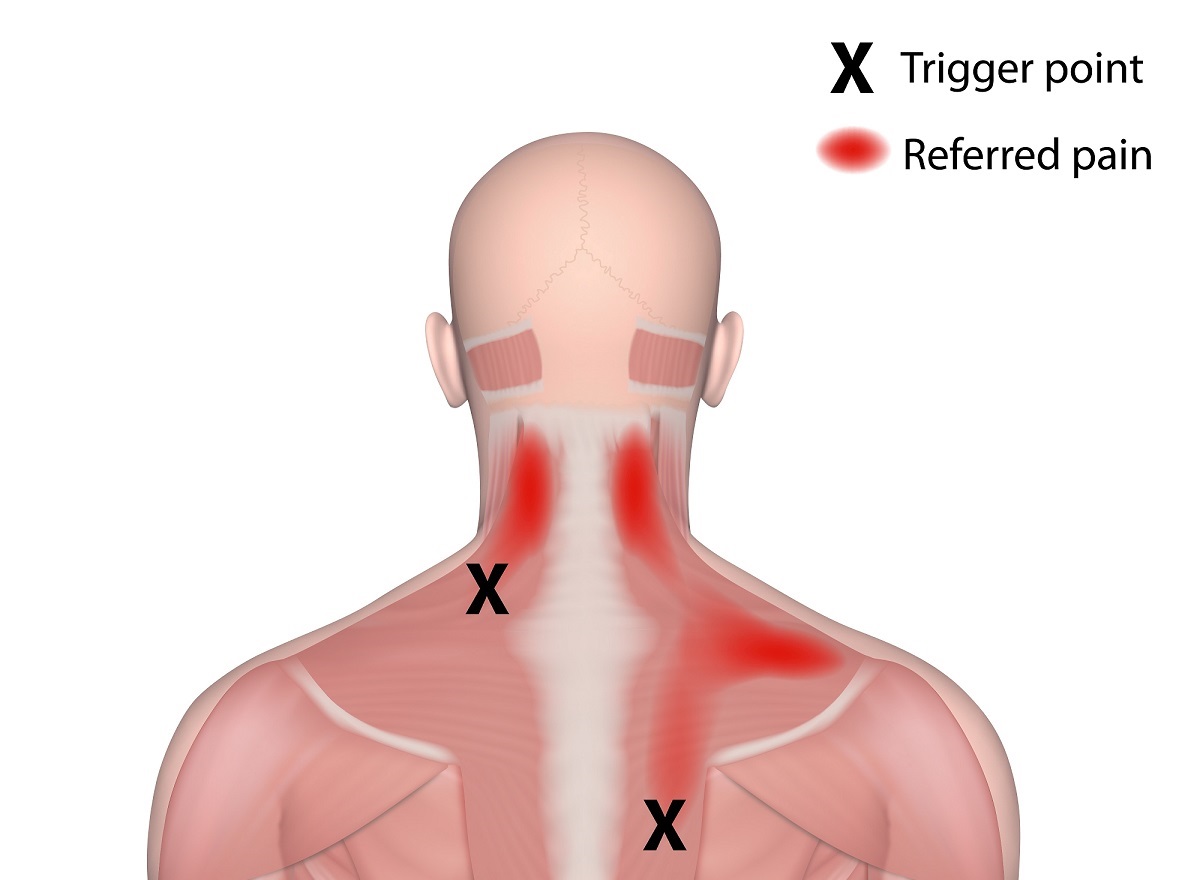
Risk Factors
Certain factors increase the risk of developing MPS, including:
- Occupations requiring repetitive motions (e.g., office workers, athletes, or manual laborers).
- Chronic stress or anxiety disorders.
- Poor ergonomic setups at home or work.
- Previous muscle injuries or surgeries.
Diagnosis of Myofascial Pain Syndrome
Diagnosing MPS can be challenging because its symptoms overlap with other conditions. Healthcare providers typically rely on a combination of physical exams and patient history. Key diagnostic steps include:
- Physical Examination: A doctor will palpate muscles to identify tender trigger points and assess pain patterns.
- Patient History: Discussing symptoms, lifestyle, and any recent injuries helps pinpoint MPS.
- Ruling Out Other Conditions: Tests like MRIs or bloodwork may be used to exclude conditions like fibromyalgia or arthritis.
Early diagnosis is crucial for effective management, as untreated MPS can lead to chronic pain cycles and reduced quality of life.
Conventional Treatments for Myofascial Pain Syndrome
Before exploring acupuncture, it’s worth noting common treatments for MPS:
- Physical Therapy: Stretching, strengthening exercises, and manual therapy can relieve trigger points.
- Medications: Over-the-counter pain relievers (e.g., ibuprofen) or muscle relaxants may provide temporary relief.
- Trigger Point Injections: Injections of corticosteroids or anesthetics into trigger points can reduce pain.
- Massage Therapy: Deep tissue massage can help release tight muscles and improve blood flow.
- Lifestyle Changes: Improving posture, managing stress, and staying active can prevent symptom flare-ups.
While these treatments can be effective, some patients seek alternative therapies like acupuncture for a holistic approach to pain relief.
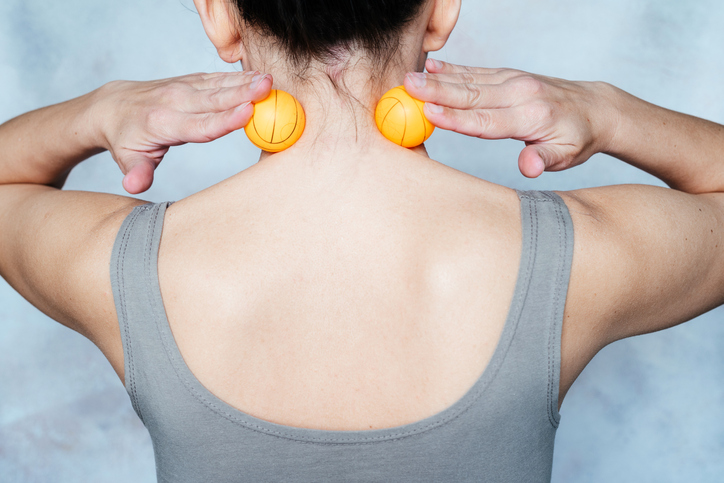
Acupuncture for Myofascial Pain Syndrome
What is Acupuncture?
Acupuncture is a traditional Oriental medicine (TOM) practice that involves inserting thin needles into specific points on the body, known as acupoints, to restore balance and promote healing. According to TOM, acupuncture works by regulating the flow of energy through pathways called meridians. In Western medicine, acupuncture is believed to stimulate nerves, muscles, and connective tissues, triggering the release of endorphins and other pain-relieving chemicals.
For MPS, acupuncture targets trigger points and surrounding tissues to alleviate pain, reduce muscle tension, and improve circulation. Its minimally invasive nature and low risk of side effects make it an attractive option for those with chronic pain.
Effectiveness of Acupuncture for Myofascial Pain Syndrome
Research supports acupuncture’s effectiveness in treating MPS. A 2017 study published in Pain Medicine found that acupuncture significantly reduced pain intensity and improved function in patients with MPS compared to a control group. Another study in The Journal of Alternative and Complementary Medicine (2019) reported that acupuncture provided longer-lasting relief than trigger point injections for some patients.
Acupuncture’s effectiveness stems from its ability to:
- Stimulate the release of endorphins, the body’s natural painkillers.
- Reduce inflammation in affected muscles.
- Improve blood flow to promote tissue healing.
- Relax hypertonic muscles, releasing trigger points.
While results vary, many patients report significant pain relief after 4-6 acupuncture sessions. Combining acupuncture with physical therapy or lifestyle changes can enhance outcomes.
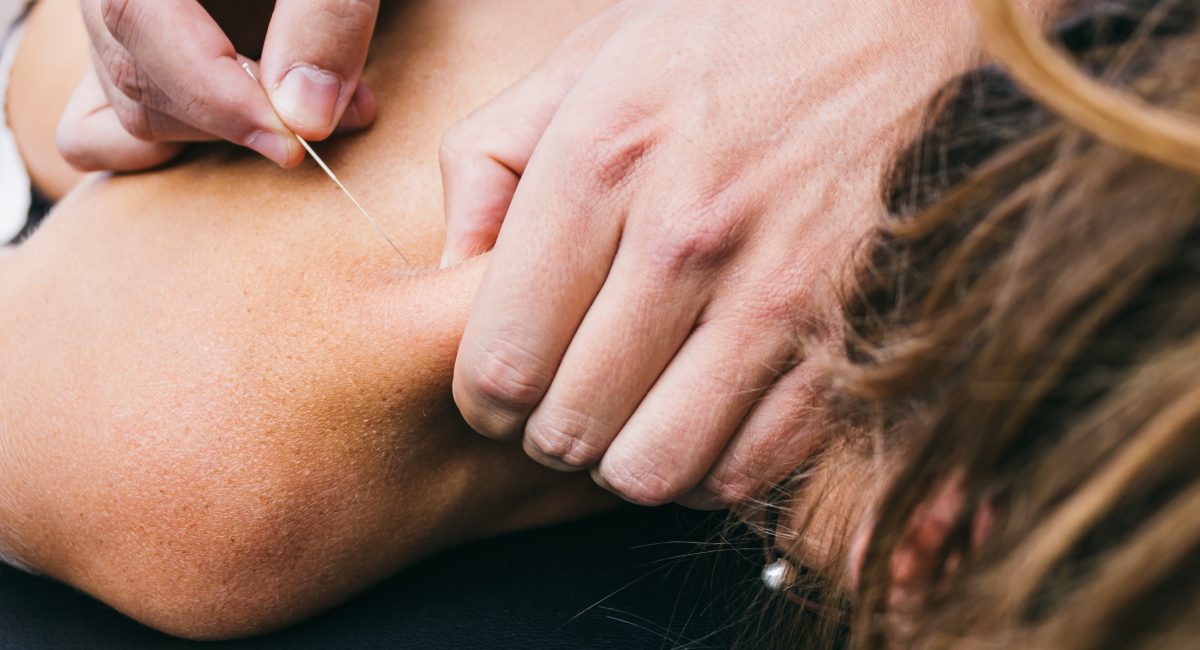
Key Acupoints for Myofascial Pain Syndrome
Acupuncturists select acupoints based on pain location and trigger point distribution. Below are the primary acupoints used for MPS, with clear explanations of their locations and purposes:
LI4 (Hegu)
- Location: On the hand, in the webbing between the thumb and index finger, at the highest point of the muscle when the thumb and finger are pressed together.
- Purpose: Known as a master point for pain relief, LI4 is used for general pain management, stress reduction, and tension relief, particularly in the upper body. It’s effective for MPS in the neck, shoulders, or arms.
- Application: Needles are inserted 5-10 mm deep, often with gentle manipulation to enhance pain relief.
GB20 (Fengchi)
- Location: At the base of the skull, in the hollows on either side of the neck, just below the occipital bone, between the sternocleidomastoid and trapezius muscles.
- Purpose: This point relieves neck and shoulder pain, tension headaches, and muscle stiffness, making it ideal for MPS in the upper back or neck.
- Application: Needles are inserted 10-15 mm at a slight angle toward the midline, often left in place for 20-30 minutes.
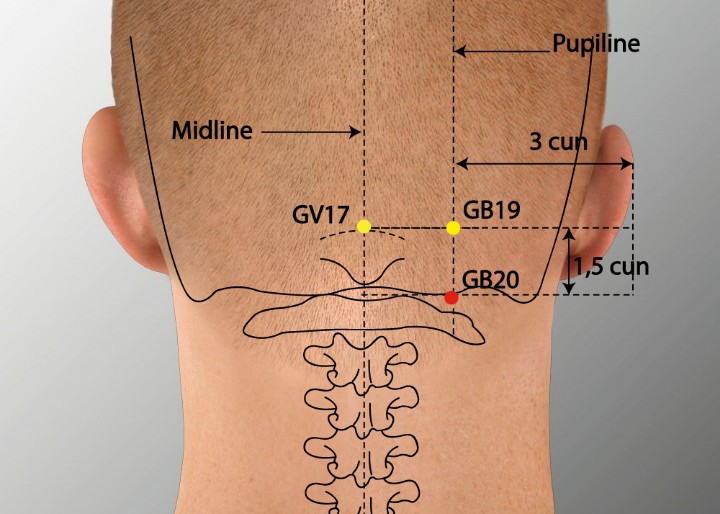
BL17 (Geshu)
- Location: On the upper back, 1.5 cun (approximately 2 finger-widths) lateral to the midline, at the level of the lower border of the T7 vertebra (below the shoulder blades).
- Purpose: BL17 promotes blood circulation, reduces muscle tension, and alleviates pain in the upper back and shoulders, a common MPS site.
- Application: Needles are inserted 10-15 mm perpendicularly, often with a warming sensation to enhance circulation.
ST36 (Zusanli)
- Location: On the lower leg, about 3 cun (4 finger-widths) below the kneecap, one finger-width lateral to the shinbone (tibia).
- Purpose: A systemic point, ST36 boosts energy, supports overall healing, and strengthens the body’s resilience to pain. It’s used for MPS to promote general muscle recovery.
- Application: Needles are inserted 10-20 mm, often with deeper insertion for robust patients.
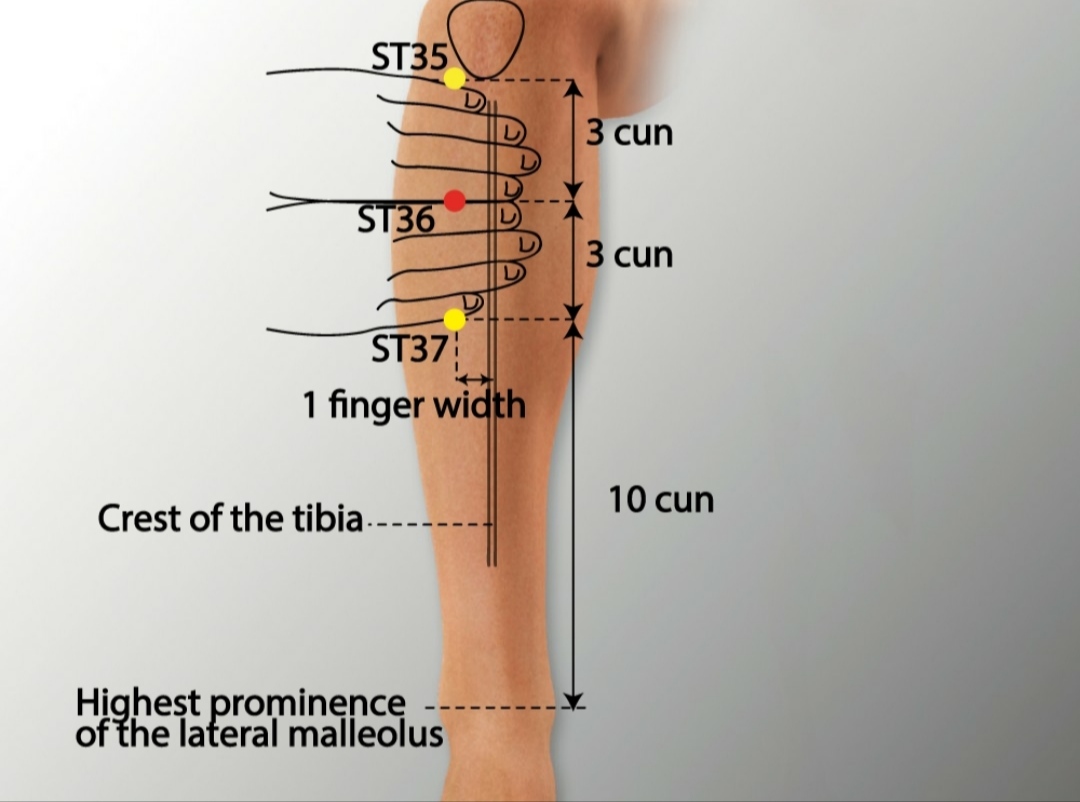
Ashi Points (Local Trigger Points)
- Location: Directly at the site of trigger points, identified by palpation as tender, knot-like areas in the affected muscle.
- Purpose: These are non-traditional acupoints specific to the patient’s pain. Inserting needles into ashi points releases muscle knots, reduces localized pain, and improves mobility.
- Application: Needles are inserted 5-15 mm into the trigger point, sometimes with electroacupuncture (mild electric current) to enhance muscle relaxation.
Treatment Details: Acupuncturists typically use 3-8 points per session, combining local (ashi) and distal points (e.g., LI4, ST36) for optimal results. Needles are sterile, single-use, and inserted to depths of 5-20 mm, depending on the muscle’s thickness. Sessions last 15-30 minutes, with electroacupuncture occasionally used for stubborn trigger points to stimulate deeper muscle release.
Benefits of Acupuncture for Myofascial Pain Syndrome
Acupuncture offers several benefits for MPS patients:
- Non-Invasive Pain Relief: Unlike injections or surgery, acupuncture is minimally invasive and requires no downtime.
- Holistic Approach: Acupuncture addresses both physical pain and underlying factors like stress or poor circulation.
- Long-Lasting Results: Many patients experience sustained relief after a series of treatments.
- Customizable Treatment: Acupuncturists tailor sessions to target specific pain areas and symptoms.
- Complementary Therapy: Acupuncture can be combined with physical therapy, massage, or medications for enhanced relief.
Potential Side Effects of Acupuncture
While acupuncture is generally safe when performed by a licensed practitioner, potential side effects include:
- Mild Soreness: Some patients experience temporary soreness at needle insertion sites.
- Bruising or Bleeding: Minor bruising may occur, especially in patients on blood thinners.
- Fatigue: A small percentage of patients feel tired after a session.
- Infection: Rare if sterile needles are used, but improper hygiene can pose a risk.
- Dizziness: Some individuals may feel lightheaded, particularly during their first session.
To minimize risks, choose a licensed acupuncturist certified by a recognized body, such as the National Certification Commission for Acupuncture and Oriental Medicine (NCCAOM).

What to Expect During an Acupuncture Session
An acupuncture session typically lasts 30-60 minutes. The process includes:
- Consultation: The acupuncturist assesses your symptoms, medical history, and pain areas.
- Needle Insertion: Thin, sterile needles are inserted into specific acupoints. You may feel a slight pinch or tingling sensation.
- Relaxation: You’ll rest with the needles in place for 15-30 minutes, often in a calm, dimly lit room.
- Post-Treatment: The acupuncturist removes the needles, and you may feel immediate relief or gradual improvement over days.
Most patients require 6-12 sessions, spaced weekly or biweekly, for optimal results. Maintenance sessions may be recommended for chronic MPS.
Acupuncture is suitable for most MPS patients, particularly those who:
- Prefer non-pharmacological treatments.
- Have not responded well to conventional therapies.
- Experience stress-related muscle tension.
- Want a complementary approach alongside physical therapy or medications.
However, acupuncture may not be appropriate for individuals with bleeding disorders, those on blood thinners, or pregnant women (certain acupoints can stimulate contractions).
Tips for Maximizing Acupuncture’s Benefits
To get the most out of acupuncture for MPS:
- Stay Hydrated: Drinking water before and after sessions supports muscle recovery.
- Combine with Stretching: Gentle stretching or yoga can enhance muscle relaxation.
- Manage Stress: Practices like meditation or deep breathing complement acupuncture’s effects.
- Communicate with Your Acupuncturist: Report any changes in symptoms to tailor treatments.
- Maintain Consistency: Regular sessions are key to sustained relief.

Conclusion
Myofascial Pain Syndrome is a challenging condition that affects daily life, but effective management is possible with the right approach. Acupuncture offers a safe, holistic, and evidence-based option for relieving MPS symptoms, targeting trigger points, and promoting overall well-being. By understanding the condition and exploring acupuncture’s benefits, patients can take proactive steps toward pain relief and improved quality of life. If you’re considering acupuncture, consult a licensed practitioner to discuss your symptoms and create a personalized treatment plan.
Fuji Wellness:
- Address: 132-0031 Matsushima 1-chome, 21-14, Tokyo, Japan
- Chat with us: Click here
- Email: sunnyphamsensei@gmail.com





